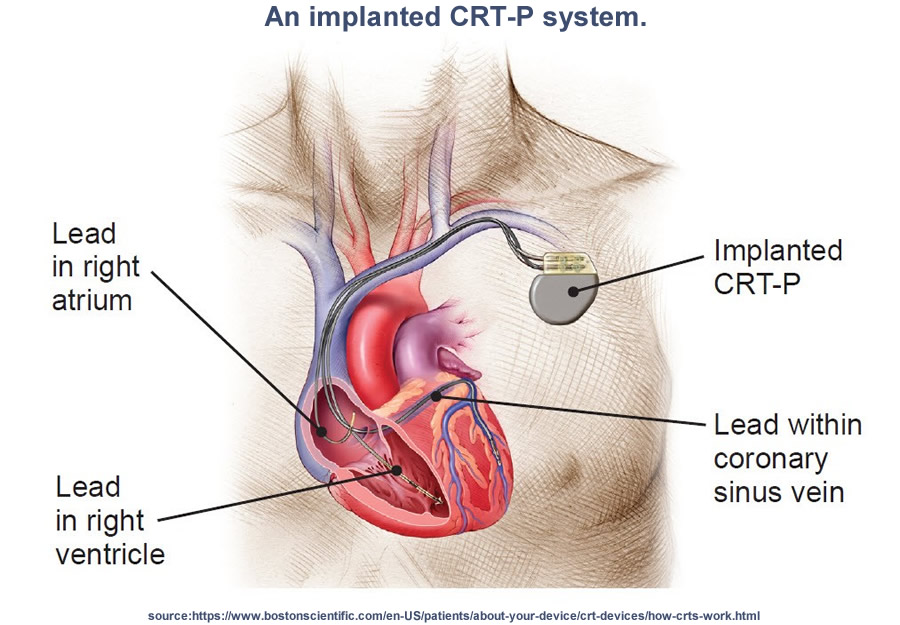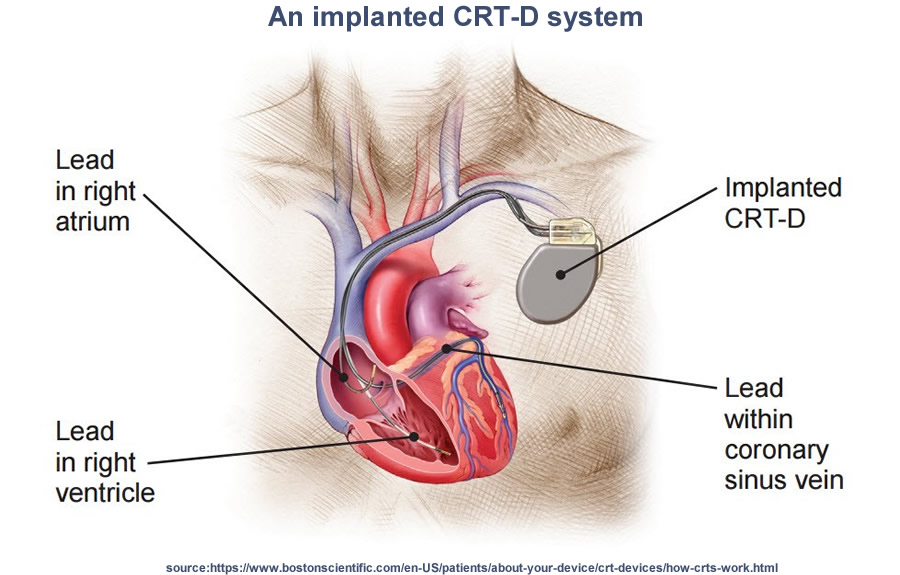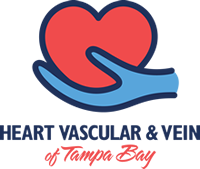Cardiac Resynchronization Therapy Devices
CRT Devices for Heart Failure
WHAT IS A CRT DEVICE?
CRT is a clinically proven treatment option for some individuals with heart failure. A CRT device sends small electrical impulses to both lower chambers of the heart to help them beat together in a more synchronized pattern. This may improve the heart’s ability to pump blood and oxygen to your body.
A CRT system is made up of two parts.
- The heart device, which is actually a tiny computer, plus a battery, contained in a small titanium metal case that is about the size of a pocket watch.
- Insulated wires, called leads, that are implanted to carry information signals from your heart to the heart device and to carry electrical impulses to your heart
After the device system is implanted, an external computer, called a programmer, located at your doctor’s office or clinic can be used to program the heart device and retrieve information from your heart device that will assist your doctor in your heart failure treatment. Your doctor will schedule periodic monitoring which may be done remotely if physician deems appropriate.
TYPES OF CRT DEVICES
There are two types of CRT devices. One is a special kind of pacemaker. It’s called a cardiac resynchronization therapy pacemaker (CRT-P) or “biventricular pacemaker.” The other is the same device, but it also includes a built-in implantable cardioverter defibrillator (ICD). This type is called a cardiac resynchronization therapy defibrillator (CRT-D).
HOW CRT-P DEVICES WORK
While functioning like a normal pacemaker to treat slow heart rhythms, a CRT-P device also delivers small electrical impulses to the left and right ventricles to help them contract at the same time so you heart pumps more efficiently

HOW CRT-D DEVICES WORK
A CRT-D is a special device for heart failure patients who are also at high risk for sudden cardiac death. While functioning like a normal pacemaker to treat slow heart rhythms, a CRT-D device also delivers small electrical impulses to the left and right ventricles to help them contract at the same time. This will help your heart pump more efficiently.
A CRT-D device can also treat dangerously fast heart rhythms (arrhythmias) that can lead to sudden cardiac arrest. If the device senses heartbeats that are dangerously fast, it delivers a shock to the heart. This shock (defibrillation) stops the abnormal rhythm. Without this life-saving therapy, the dangerously rapid rhythm could lead to death in just minutes.

YOUR CRT DEVICE BATTERY
Just like any battery, the battery in your CRT-P or CRT-D will run out over time. Since the battery is permanently sealed inside your device, it can’t be replaced when its energy is depleted. So if your battery runs out, your entire device will need to be replaced. The battery life depends on the settings your doctor programs and how much therapy you receive.
Your CRT device will regularly check its own battery and your doctor will check to see how much energy it has left at each follow-up visit. In addition, your doctor can turn on a feature that makes your device beep when replacement time is near. Call your doctor immediately if your device beeps.
CRT-P and CRT-D Implant Risks
While complications don’t happen very often, it’s important to know that there are risks associated with the implantation of any device or lead. You should talk with your doctor about these risks, including the ones below.
Some of the risks encountered during the implant procedure include, but are not limited to, the following:
- Bleeding
- Formation of a blood clot
- Damage to adjacent structures (tendons, muscles, nerves)
- Puncture of a lung or vein
- Damage to the heart (perforation or tissue damage)
- Dangerous arrhythmias
- Heart attack
- Stroke
- Death
Some of the risks encountered after the system is implanted may include, but are not limited to, the following:
- You may develop an infection
- The device may move from the original implant site
- The lead(s) may move out of place in the heart
- The electrodes on the lead or the pacing pulses may cause an irritation or damaging effect on the surrounding tissues, including heart tissue and nerves
- You may receive a shock or pacing therapy when it is not needed
- The device might not be able to detect or appropriately treat your heart rhythms
Be sure to talk with your doctor so that you thoroughly understand all the risks and benefits associated with the implantation of a CRT system.
Information on this site should not be used as a substitute for talking with your doctor. Always talk with your doctor about diagnosis and treatment information.
Source: Boston Scientific
